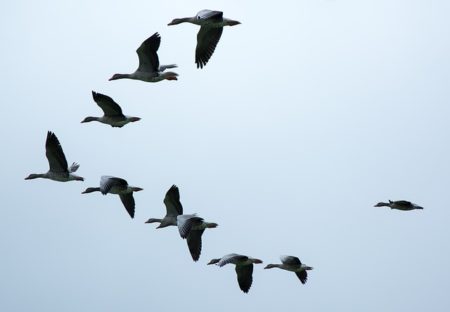
First, let us see how a bird is lifted up. As a bird flap its wings, it gives downward force on air. The reaction of two downward forces acts at the center and towards the body of the bird lifting it up.
It can be compared to bow and arrow. The pulled string gives a reaction force on the arrow. Hence it is fired straight forward.
Once the bird takes to flight, another principle comes into being. Birds wings are in the aerofoil shape (another article). When the aerofoil moves fast in the air, the pressure goes down on the up-side but increases on the down -side. High pressure below the wings keep the bird afloat.
Next, another phenomenon takes place. At the edges of wings, the air moves from high pressure to low pressure. That is, from bottom of wings to top creating vortices of air flow. As the bird moves forward, it will keep on creating spiral of air flow. We know, a circular air flow has both upward and downward flow. Suppose, two more birds move into two vortices of air generated by two wings and fly exactly on the upward flow of air, they will get a lift and they can fly using less effort. Then two more birds follow suit and it goes on and on. Finally, we see, 'V' shaped formation of birds.
The 'V' shape has another advantage, it can pierce through mass of air easily. That is why, airplanes have somewhat sharp nose.
Birds's advantage is air-plane's disadvantage. Air vortices are created at the tip of plane's wing also. But it gives pressure on the wings and also some drag is produced resulting in more fuel consumption. Hence folded wing-lets are attached at the end of the wings to prevent the formation of vortices.
Note: Jonathan Livingston wrote a book called "seagull" which falls between fiction and non-fiction. The hero of the book, a sea gull not just flies for the sake of searching and picking food but it made the flight into an art. The lesson from the book: "embrace your passion".
----------------------------------------

